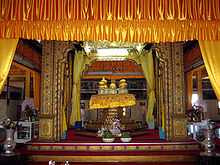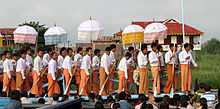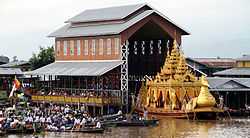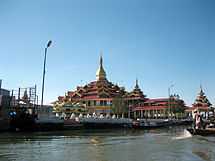Hpaung Daw U Pagoda
| Hpaung Daw U Pagoda ဖောင်တော်ဦးဘုရား | |
|---|---|
|
The Hpaung Daw U Pagoda | |
 Hpaung Daw U Pagoda Location within Burma | |
| Information | |
| Denomination | Theravada Buddhism |
| Founded | (Unknown) |
| Country | Myanmar |
| Coordinates | 20°28′28″N 96°53′25″E / 20.47444°N 96.89028°E |

Hpaung Daw U Pagoda Burmese: ဖောင်တော်ဦး ရုပ်ရှင်တော် မြတ်စွာဘုရား [pʰàʊɴ dɔ̀ ʔú pʰəjá]; also spelt Hpaung Daw Oo or Phaung Daw Oo) is a notable Buddhist site in Myanmar (formerly Burma), located on the Inle Lake in Shan State.
Surrounding the Pagoda, and in the basement are shops selling traditional Shan and Burmese merchandise.
Images
The pagoda houses five small gilded images of Buddha, which have been covered in gold leaf to the point that their original forms cannot be seen. The gold-leaf application to such excess is relatively recent. Old photographs hanging on the monastery walls show some of the images in a more pristine form. It is reported that some gold has been removed on occasion to reduce its mass. Although the monastery is open to all for veneration, only men are permitted to place gold leaf on the images. Another part of the ritual for pilgrims is to place a small robe or thingan around the images, and to take the robe back to their houses and place it on their own altar as a token of respect for the Buddha and his teachings.


The images are of differing sizes, range from about nine to eighteen inches tall. Being essentially solid gold, the images are extremely heavy. It is believed that the Buddha images were brought to Inlay Lake by King Alaungsithu.
Annual festival=
Annually, during the Burmese month of Thadingyut (from September to October), an 18-day pagoda festival is held, during which four of the Buddha images are placed on a replica of a royal barge designed as a hintha bird and taken throughout Inlay Lake. One image always remains at the temple. The elaborately decorated barge is towed by several boats of leg-rowers rowing in unison, and other accompanying boats, making an impressive procession on the water. The barge is towed from village to village along the shores of the lake in clockwise fashion, and the four images reside at the main monastery in each village for the night.
The high point of the festival is on the day when the images arrive at the main town of Nyaung Shwe, where most pilgrims from the surrounding region come to pay their respects and veneration. In the past, the Saopha of Yawnghwe would personally welcome the images. The images would be taken from the barge and a grand procession would take them to the palace or haw of the Saopha, entering the prayer hall from the eastern entrance, and where it would reside for a few hours. The public was allowed inside the prayer hall of the haw to pay their respects. Then the images would be taken to the main temple in Nyaung Shwe. Since the mid-1960s, the images have bypassed the visit to the haw and taken directly to the temple. It is now usually welcomed to Nyaung Shwe by some high-ranking official in the government.
Sometime in the 1960s during a particularly windy day, when the waves were high on the lake, the barge carrying the images capsized, and the images tumbled into the lake. It was said that they could not recover one image, but that when they went back to the monastery, the missing image was miraculously sitting in its place.
